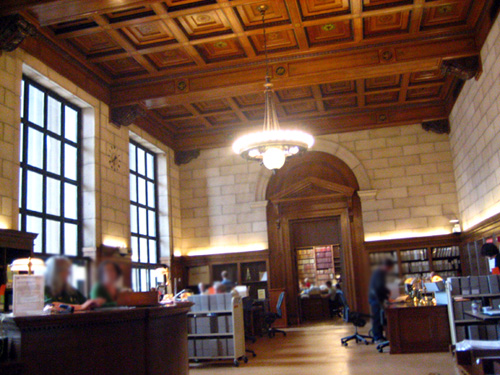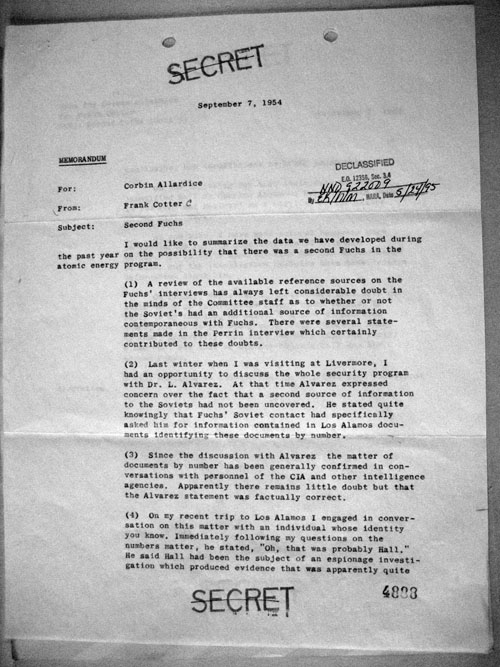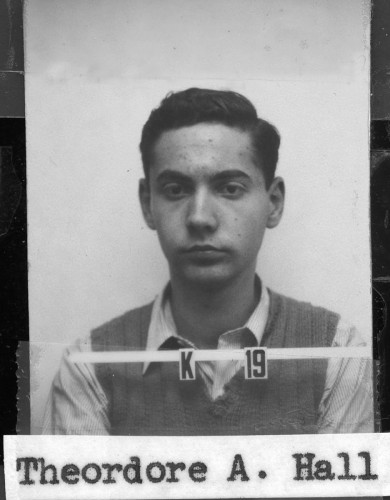It’s Archive Week still, and I’m having a good time in the Legislative Archives, in downtown Washington, DC. I thought I would share an interesting document I came across today, with a few notes about my archive technique, along with an interesting document about the possibility of a “second Fuchs” at Los Alamos, from 1954.
The Legislative Archives are in a relatively old part of the National Archives. Lots of fancy chandeliers and wood panels and blocks of stone. It’s a pretty place to do research. They don’t make research rooms like this anymore:

A surreptitiously snapped photo of the main room. Faces blurred to protect the innocent.
My general archives setup is my laptop, my camera (a relatively unexciting Canon PowerShot SD450 Digital Elph), an extra battery (an absolute must), and the battery charger. I’m a minimalist when it comes to snapping photos of documents — I have a “just good enough” approach to it, which means I’m willing to sacrifice quality for speed. So I don’t use tripods, I don’t use fancy lighting, I don’t use a fancy camera, and I don’t use a scanner. I just snap them quickly and try to keep the lighting uniform. It’s probably not good enough to reprint in a book or article, but it works for research. My whole game plan is getting lots and lots of documents and reading them somewhere other than an archive, so when I’m in the archive, I’m just trying to vacuum up the entire thing into JPGs (which I late run some simple filters on and turn into PDFs). If I ever really need a better quality version of a document, I’ll have to get it when I’m back another time, but that has (so far) been extremely rare (at least in contrast to the volume of documents I process).

My basic technique, as taken with my cell phone camera.
The whole trick is to just make sure that the document more or less fits the frame and is in focus. The lighting just needs to be uniform — it doesn’t need to be bright (in fact, low contrast lighting is best). It’s easy to normalize a uniformly-lit document to reduce the grays and bring out the blacks. What’s hard is if you have lots of variation in the lighting — bright spots, or dark shadows, make normalization tough, and you end up with bad looking photos. You get better at holding your hand “just steady enough for the sensor” with practice.
If I’m really cooking, I can photograph a document every second or two. So when I know I want a whole folder of things, I can really get a lot. I shoot first, ask historiographic questions later.
To further streamline the process, I take basically no notes during the process. I usually have an Excel spreadsheet that I’ve filled out with things I plan to look at (just box numbers and basic folder titles), something made possible by getting copies of the Finding Aids where possible (harder than it sounds, when one is talking about the National Archives, which doesn’t actually make the detailed Finding Aids available to people who aren’t there in person). I then just check off if I saw something, or if it was lost or denied to me, for future reference. For the actual matter of organizing the photos, I just always have a photo of the box reference (which says what collection/series/box it is), then a photo of the folder label, then the documents in the folder. I then save all of those documents in the same place (e.g. “Box 53 – AEC Security” for a folder on “AEC Security” in box 53 of a given collection, in this case, Appendix III of the Joint Committee on Atomic Energy files). Later I can just automate the processing of the JPGs using a Photoshop “Action” that just adjusts the levels, rotates the files, re-saves them with some compression, and then use an Adobe Acrobat macro to assemble them into PDF files and run OCR on them (which works pretty well, even with reasonable amounts of compression). I end up with somewhat large PDFs that are somewhat searchable. Works for me.
Well. That’s probably more detail than you wanted. But now you know — my secrets are out there.
Here’s the document I am seen photographing above, which is pretty interesting. It’s a “Secret” memorandum from Frank Cotter to Corbin Allardice, two JCAE staffers, from September 1954. It concerns the possibility of a “second Fuchs” at Los Alamos. 1
There are a few interesting things here. One is that Luis Alvarez is a source of some of the information that the JCAE staffers have regarding security matters. Not a total surprise, but that they’d be getting their security tips from a Livermore scientist first, and the CIA “and other intelligence agencies” second, is an interesting situation.
Second is the identification of the “second Fuchs” as “Hall,” whom Cotter erroneously thinks is named Charles Augustus Hall. It was undoubtedly Theodore Alvin Hall, a Harvard grad whose work as a spy was only publicly acknowledged in the 1990s. Hall’s Soviet code-name was, appropriately, “Mlad,” or “Youth” — he was only 19 when he started spying. (He believed that if the US had an atomic bomb, it was only fair/sensible for the Soviets to have one as well. Balance of power and all that.)
The JCAE staffed was convinced that the AEC knew nothing about Hall, which I’m not sure is true (the FBI had a pretty good idea, and Hall was cut out of atomic matters once it became clear he was a spy). Interestingly, Cotter says he discussed Hall with “an employee of an intelligence agency known to you” — the FBI? — who told him that “You have a gold mine there, but it is the wrong gold mine.” Cotter thinks this means that the Hall case “was really a bad one,” but that Hall was not the “second Fuchs.” I’m not sure what was meant by the “gold mine” comment, myself. What’s interesting, though, is that even within their JCAE sanctum, Cotter goes to great length not to name his sources, even the agencies. That’s a lot of compartmentalization for Congressional committee staffers.
Hall was the subject of Joseph Albright and Martha Kunstel’s 1997 book, Bombshell: The Secret Story of America’s Unknown Atomic Spy Conspiracy. He was never tried for his espionage, though the FBI was pretty well aware of it from the VENONA transcripts. Prosecution of Hall probably would have been difficult without exposing VENONA as a source, since they lacked any confessions (remember that the Rosenbergs were prosecuted mostly on the basis on the confession of David Greenglass, which removed the need for VENONA evidence; Fuchs also confessed).
- Citation: Frank Cotter to Corbin Allardice, “Second Fuchs,” JCAE document 4888, (7 September 1954), in Records of the Joint Committee on Atomic Energy, RG 128, National Archives and Records Administration, Washington, D.C., Series 2: General Subject Files, Box 53, “AEC Security.”[↩]




[…] post on Day 2 of Archives Week got a few people asking me if I could elaborate on my post-processing methods for all those photos […]
Alex,
Actually, the detail on how you do your archival research is pretty interesting and useful. To me anyway.
Thanks.
Given that VENONA was involved, could “an intelligence agency known to you” be the NSA, whose existence was itself a secret at that point?
Hmm, that’s an interesting idea. Honestly, I’ve no clue.
Alex, do you think document cameras are at a disadvantage compared to conventional/hand-held ones? I’ve been negotiating with the British National Archives for permission to use this http://www.youtube.com/watch?v=uinMOzewTOw
Not only are they uncomfortable with my request, they also think there’s nothing useful about the device in comparison to regular cams. I’ve got no experience at all taking shots at the archives, but it just seems to make sense to me that a device designed specifically for documents would be better.
Please Help!!!
How strange. Archivists are nothing if not a picky, rule-based bunch. (I say this with great affection for the archivists I’ve worked with.) My general advice is to try and figure out who actually has discretionary power over such decisions — it is rarely the person who works at the front desk, at least in the United States.
I don’t know about the advantages or disadvantages but that strikes me as hardly the point, no? I mean, if it functionally works like a camera-on-a-tripod in every respect, then why should it be considered different from one?
If it helps, I have seen people at the US National Archives using such machines.
Thanks Alex, I feel more confident making a case now. It works just as a cam on a tripod, but with the advantages of being more portable.